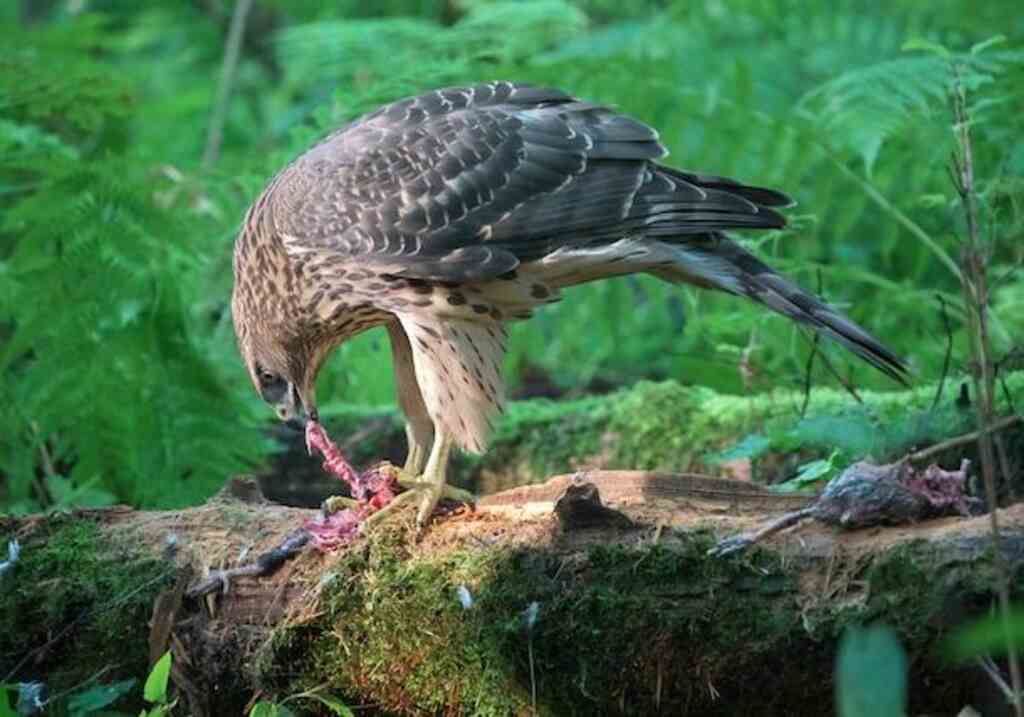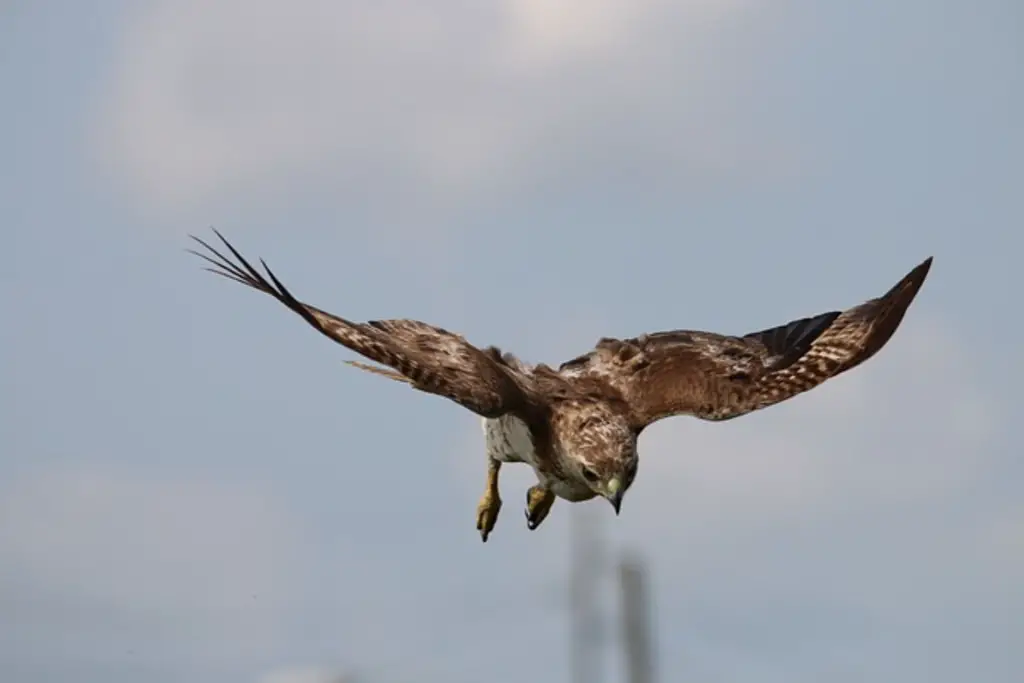In nature, hawks are known for their remarkable hunting skills, agility, and predatory behavior. They are often portrayed as fierce and powerful birds, soaring through the sky in search of their next prey.
However, there is a lesser-known aspect of hawk behavior that begs the question: Do hawks eat carrion? At first glance, the idea of a hawk consuming carrion may seem counterintuitive.
After all, hawks are known for their ability to hunt and catch live prey, so why would they resort to eating carrion?
Yet, as we delve deeper into the life of a hawk, we find that their diet is not as straightforward as we may have thought.
In this article, we will explore the role of carrion in the hawk’s diet, the reasons why hawks may eat carrion, and the impact that carrion consumption has on their health and hunting behavior.
By the end of this article, we hope to provide a comprehensive understanding of this often-misunderstood aspect of hawk behavior.
Table of Contents
- 1 Key Takeaways
- 2 Understanding the Role of Carrion in Hawk’s Diet
- 3 Do Hawks Eat Carrion?
- 4 Reasons Why Hawks Eat Carrion
- 5 Common Species of Hawks that Eat Carrion
- 6 Carrion Preference of Hawks
- 7 Impact of Carrion Consumption on Hawk’s Health
- 8 Carrion Consumption in Relation to Hawk’s Hunting Behavior
- 9 Role of Hawks in Ecological Balance
- 10 Myths and Misconceptions about Hawks and Carrion
- 11 Frequently Asked Questions
- 11.1 How long can hawks survive without eating carrion?
- 11.2 Do all species of hawks eat carrion?
- 11.3 Is there a difference in the carrion preference between male and female hawks?
- 11.4 Can hawks get sick from consuming carrion?
- 11.5 Are there any negative impacts on the environment if hawks consume too much carrion?
- 12 Conclusion
- 13 Author
Key Takeaways
- Hawks do eat carrion in addition to live prey, with some species relying solely on carrion as a food source.
- Eating carrion may be a survival strategy for hawks, particularly during times of food scarcity or when competition for live prey is high.
- Hawks have adapted to include carrion in their diet as a survival strategy, especially during times of food scarcity, and are able to digest and utilize the nutrients in carrion efficiently.
- Conservation of hawks as scavengers is crucial for preserving the balance of their habitats and the wider ecosystem, as they play an important role in maintaining ecological balance as scavengers and contribute to the health of their ecosystem by consuming carrion and controlling populations of small mammals and birds.
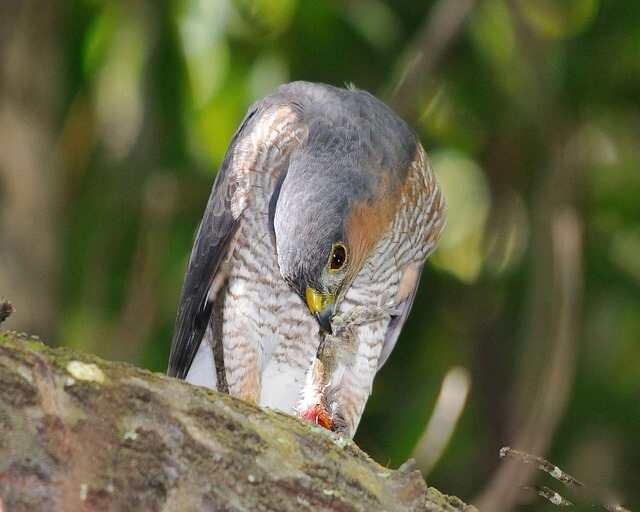
Understanding the Role of Carrion in Hawk’s Diet
The examination of hawk’s diet reveals that carrion plays a significant role, providing essential nutrients and sustenance for these avian predators.
Understanding the nutritional value of carrion is crucial in comprehending its importance in the hawk’s diet.
As scavengers, hawks play a crucial role in the food chain dynamics, as they help in the decomposition and recycling of organic matter.
Carrion consumption also provides hawks with a source of protein and fat, which are essential for their survival, especially during the winter months when prey may be scarce.
Research has shown that carrion makes up a significant portion of the hawk’s diet, with some species relying solely on carrion as a food source.
Despite its importance, carrion consumption can also pose risks to hawks, as it may expose them to diseases and toxins.
However, the benefits of carrion consumption outweigh the risks, and hawks have evolved to tolerate these risks.
The impact of carrion consumption on food chain dynamics is significant, as it provides a direct link between scavengers and predators, ensuring that no organic matter goes to waste.
The understanding of these dynamics is crucial in comprehending the role that hawks play in the ecosystem.
The subsequent section will explore the reasons why hawks eat carrion, shedding more light on this fascinating aspect of their diet.
Do Hawks Eat Carrion?
Yes, some hawks, such as the Red-shouldered Hawk, do eat carrion as part of their diet. While hawks are primarily active hunters, they may scavenge on carrion when available. Carrion can include roadkill or discarded animal remains. However, carrion consumption is not a typical behavior for most hawk species.
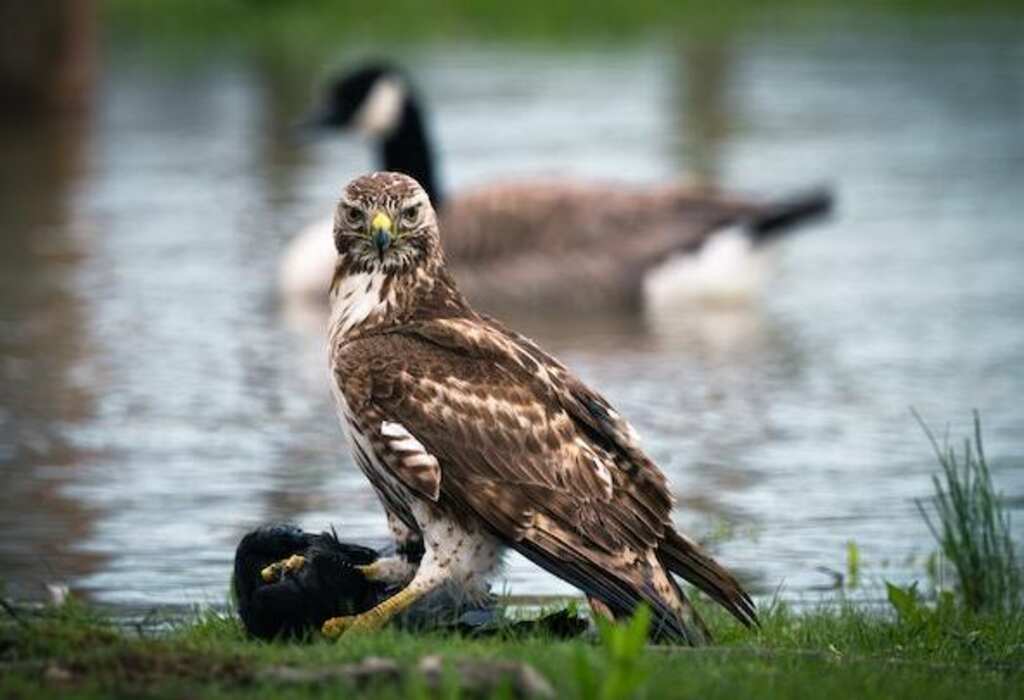
Reasons Why Hawks Eat Carrion
Hawks are known to eat carrion in addition to live prey, and there are several reasons why they engage in this behavior.
One reason is the scarcity of live prey in their environment, which may force them to scavenge for food.
Additionally, hawks are opportunistic feeders and will take advantage of any available food source.
Finally, eating carrion may be a survival strategy for hawks, particularly during times of food scarcity or when competition for live prey is high.
Scientific research has provided empirical evidence for these behaviors and their importance in the diet and survival of hawks.
Scarcity of Live Prey
Amidst the scarcity of live prey, hawks may turn to scavenging for sustenance, as carrion becomes a more readily available food source. This behavior can have significant effects on the ecosystem and impact the hawk population.
As opportunistic predators, hawks are adapted to consume a wide range of prey, including small mammals, reptiles, and birds.
However, when live prey is scarce, hawks have been observed feeding on carrion, or the remains of dead animals.
This behavior is not uncommon among raptors, as they have evolved to take advantage of all available food sources.
In fact, studies have shown that carrion can make up a significant portion of a hawk’s diet, especially during the winter months when prey is scarce.
While scavenging for carrion may provide a reliable source of food, it can also have negative impacts on the hawk population if it leads to an over-reliance on this food source.
Additionally, hawks that feed on carrion may be more susceptible to diseases and parasites, further affecting their population.
Understanding the reasons behind hawk’s carrion feeding behavior is crucial for managing and conserving these apex predators.
Opportunistic Feeding Behavior
In times of scarcity, raptors like hawks exhibit an opportunistic feeding behavior that allows them to adapt to changing environmental conditions. This behavior is not limited to preying on live animals but also includes scavenging on carrion.
Studies show that hawks have a highly adaptable digestive system that allows them to digest a wide variety of foods, including carrion.
The ability to feed on carrion offers adaptive advantages to hawks, allowing them to survive when prey is scarce.
However, this opportunistic feeding behavior has ecological implications, as it can contribute to the spread of disease and impact the population dynamics of other scavengers.
Despite these implications, the ability to feed on carrion is an important survival strategy for hawks and other raptors in times of scarcity.
Survival Strategy
The survival strategy of opportunistic feeding behavior is a well-documented phenomenon in the animal kingdom, with many species adapting to changing environmental conditions by altering their dietary preferences.
Hawks are one such species, and they have been observed consuming carrion as a means of survival.
While the consumption of carrion may not be the primary food source for hawks, it can provide much-needed nutrients during times of scarcity.
However, the impact of carrion consumption on hawk migration is not fully understood and requires further investigation.
Additionally, hawks have been known to use carrion for nesting materials, demonstrating their resourcefulness in utilizing all available resources.
Studies have shown that hawks are capable of identifying fresh carrion and avoiding those that are contaminated or diseased.
This behavior may help to prevent the spread of disease among hawk populations.
Overall, the consumption of carrion is just one aspect of the opportunistic feeding behavior that allows hawks to survive in changing environments.
In the subsequent section, we will explore the common species of hawks that eat carrion.
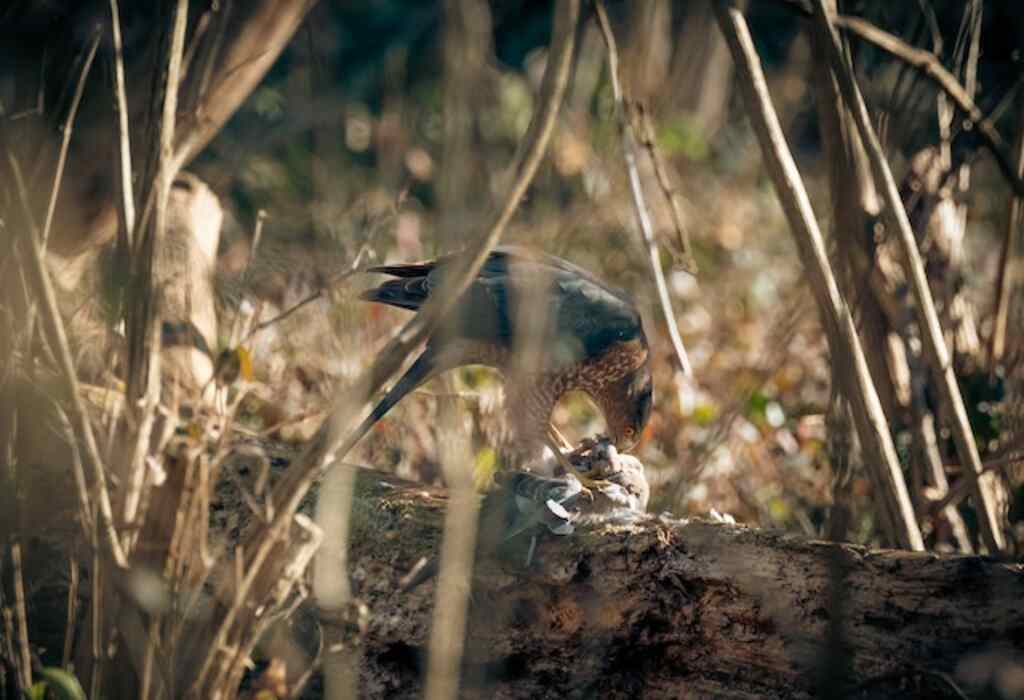
Common Species of Hawks that Eat Carrion
Various species of hawks, such as red-tailed hawks and Red-shouldered Hawks, have been observed consuming carrion as a regular part of their diet.
Scavenger behavior in hawks is not uncommon, and these birds play a significant role in the ecological impact of their environment.
The anatomy of hawks, with their sharp talons and beaks, allows them to easily tear apart and consume carcasses.
Research has shown that hawks have a preference for fresh carrion, as it provides them with the necessary nutrients and energy.
Despite being known as predators, hawks have adapted to include carrion in their diet as a survival strategy, especially during times of food scarcity.
The consumption of carrion also helps in maintaining the balance of the ecosystem by removing dead animals and preventing the spread of diseases.
Moving forward, the carrion preference of hawks will be further explored to understand their behavior and its impact on the environment.
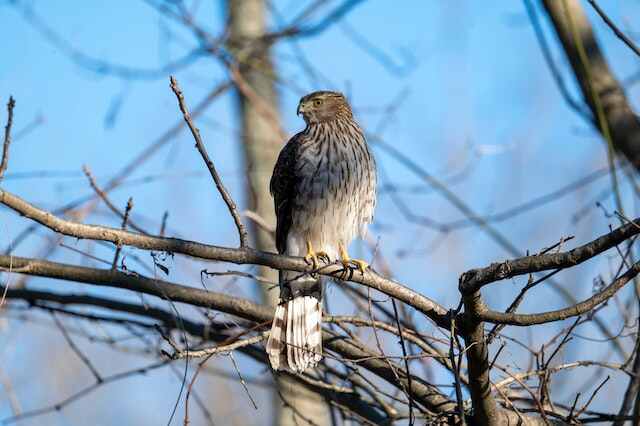
Carrion Preference of Hawks
The carrion preference of hawks is largely influenced by several factors, including the freshness and age of the carrion, the size and type of the carrion, and competition with other scavengers.
Research has shown that hawks tend to prefer fresh carrion over older ones, as the former contains more nutrients and is less contaminated by bacteria.
Additionally, hawks have been observed to favor smaller carrion, such as rodents, over larger ones like deer, as the former are easier to handle and consume.
Finally, hawks must compete with other scavengers, such as vultures and crows, for access to carrion, leading to complex interactions and behaviors.
Freshness and Age of Carrion
Assessing the degree of decay of carrion is crucial in determining whether hawks will feed on it. Hawks prefer fresh carrion, as it is easier to consume and provides more nutrition.
However, they are known to feed on carrion that is a few days old if no fresh prey is available.
Carrion preservation plays a significant role in the availability of fresh carrion. If carrion is not properly preserved, it may become unpalatable to hawks and other scavengers.
Scavenger competition also affects the availability of carrion, as larger scavengers such as vultures and eagles may consume the majority of the carrion before hawks have a chance to feed.
Research has shown that hawks are able to detect the freshness of carrion through olfactory cues, and they are more likely to approach fresh carrion that emits a strong scent.
Overall, the freshness and age of carrion play a vital role in determining whether hawks will feed on it.
The size and type of carrion will also affect their feeding behavior, which will be discussed in the following section.
Size and Type of Carrion
The size and type of carrion present different challenges for hawks as they scavenge for food. Hawks are opportunistic feeders and will consume a variety of carrion, including small mammals, birds, and reptiles.
The nutritional value of carrion is dependent on the freshness and age of the carcass, as well as the size and type of prey.
Hawks must be cautious when feeding on larger carrion, as they may not be able to consume the entire carcass and may become vulnerable to predation while feeding.
Additionally, competition with other scavengers, such as vultures and crows, may limit access to carrion and force hawks to hunt for live prey.
Research has shown that hawks are able to digest and utilize the nutrients in carrion efficiently, indicating that scavenging may be an important component of their diet.
As such, understanding the role of carrion in the diet of hawks can provide insight into the ecological niche they occupy and the challenges they face as opportunistic feeders.
Competition with Other Scavengers
Competition with other scavengers poses a significant challenge for hawks as they scavenge for food. The competition dynamics of scavenging efficiency are complex, and hawks must compete with other species such as vultures, crows, and raccoons.
Hawks are limited in their scavenging capabilities due to their smaller size and less developed beaks, which make it difficult for them to access and consume carrion.
Additionally, they face competition from larger scavengers, such as vultures, who can quickly consume larger carrion and dominate food sources.
Studies have shown that hawks are able to compensate for the disadvantage of their smaller size by being more agile and quicker in their movements, allowing them to access smaller carrion and navigate through denser vegetation.
However, this advantage is limited, and hawks are often forced to rely on their hunting abilities to supplement their scavenging.
Overall, the competition for food sources and the scavenging efficiency of hawks play a crucial role in their survival and health.
Understanding these factors is essential for conservation efforts and the management of wildlife populations.
The impact of carrion consumption on hawk’s health is an important aspect to consider, as it can affect their overall fitness and reproductive success.
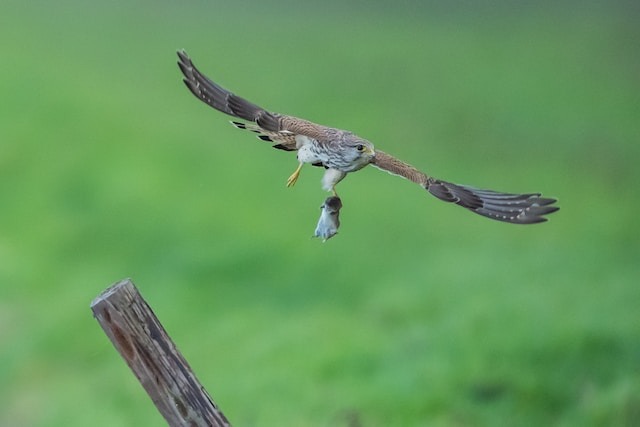
Impact of Carrion Consumption on Hawk’s Health
Ironically, consuming carrion can have detrimental effects on the health of hawks. While carrion provides a source of nutrition for these birds, it also exposes them to potential health risks.
Carrion can be contaminated with bacteria, viruses, and other pathogens that can cause infections and diseases.
In addition, consuming carrion can lead to a build-up of toxins in the hawk’s body, which can cause long-term damage to their health.
Research has shown that hawks that consume carrion are more likely to have higher levels of lead and other heavy metals in their blood, which can lead to neurological and reproductive problems.
Therefore, while carrion may seem like an easy meal for hawks, it can ultimately have negative consequences on their health and well-being.
This highlights the importance of understanding the impact of carrion consumption on hawk populations, and the need to promote healthy hunting behaviors in these birds.
Carrion Consumption in Relation to Hawk’s Hunting Behavior
Carrion consumption plays a significant role in the hunting behavior of hawks and understanding this relationship is crucial for promoting the well-being of these birds.
The amount of carrion available in their environment and its nutritional value are key factors that affect a hawk’s carrion consumption behavior, which is not necessarily related to their hunting activity.
Studies have shown that carrion can provide important nutrients for hawks, especially during times of food scarcity or breeding season.
Additionally, consuming carrion can reduce the energy expenditure required for hunting and provide hawks with a less risky food source.
However, excessive consumption of carrion can lead to health problems such as bacterial infections and parasites.
Therefore, it is important to monitor the carrion consumption behavior of hawks in their natural environment.
By doing so, we can better understand the role that carrion plays in their diet, and ultimately support the well-being of these important predators.
Moving forward, it is important to consider the role of hawks in ecological balance, as they play a crucial role in maintaining the health of ecosystems.
Role of Hawks in Ecological Balance
Hawks play an important role in maintaining ecological balance as scavengers, a valuable ecosystem service.
As top predators, they contribute to the health of their ecosystem by consuming carrion and controlling populations of small mammals and birds.
Conservation of hawks as scavengers is therefore crucial for preserving the balance of their habitats and the wider ecosystem.
Empirical evidence and research demonstrate the importance of hawks as scavengers, highlighting the need for continued conservation efforts to ensure their survival.
Scavenging as Ecosystem Service
Scavenging plays a vital role in maintaining the balance of ecosystems, as it serves as a natural waste disposal mechanism.
Hawks, along with other birds of prey, are known to scavenge on carrion, which not only helps to control the spread of disease and parasites, but also provides economic benefits and cultural significance by serving as a food source for other animals and humans.
Hawks have adapted anatomical features, such as a sharp beak and talons, that allow them to tear and consume a wide variety of carrion.
Empirical evidence and research have shown that hawks, despite being primarily known for hunting live prey, can consume carrion as well.
However, the scavenging behavior of hawks and other birds of prey is threatened by human activities such as habitat destruction and poisoning.
Thus, conservation of hawks as scavengers is crucial in maintaining the ecological balance of ecosystems.
Conservation of Hawks as Scavengers
Conserving the role of scavengers like hawks in ecosystems is vital to maintaining the balance of natural waste disposal mechanisms.
Hawks are known to play an important role in maintaining the health of ecosystems by consuming carrion and controlling the population of small prey animals.
Conservation strategies that aim to protect hawks and their habitats can have significant economic benefits by supporting ecotourism and promoting the health of ecosystems.
Studies have shown that hawks are effective scavengers that can consume large quantities of carrion, which helps to prevent the spread of disease and reduce the amount of waste in the environment.
However, there are still misconceptions about hawks and their role as scavengers, which can lead to negative attitudes towards these birds and hinder conservation efforts.
Understanding the true nature of hawks as scavengers is essential for developing effective conservation strategies and promoting the health of ecosystems.
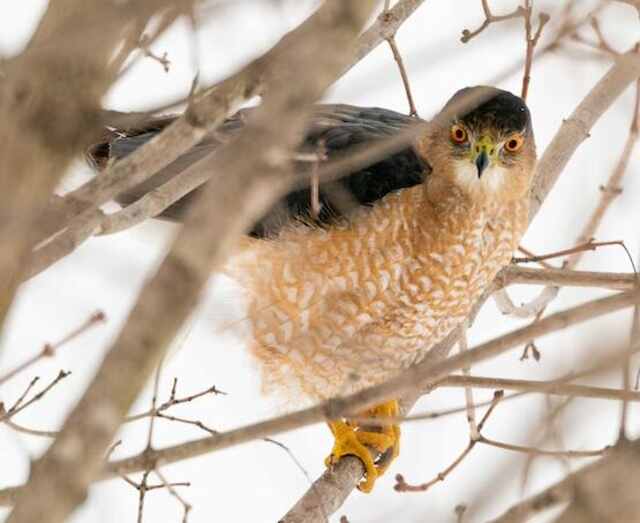
Myths and Misconceptions about Hawks and Carrion
Hawks are often misunderstood when it comes to their role in the ecological system, particularly in their relationship with carrion.
Contrary to popular belief, hawks are considered clean animals and do not typically eat carrion.
However, there is a misconception that hawks are carriers of disease, which can have negative impacts on their reputation and conservation efforts.
Through scientific research and empirical evidence, it is important to distinguish the myths and misconceptions surrounding hawks and carrion to better understand their role in the ecosystem.
Hawks as Clean Animals
Like meticulous housekeepers, hawks are known for their fastidiousness in keeping their nests and territories clean.
They spend a considerable amount of time grooming their feathers and preening to maintain their hygiene.
This behavior is critical for their survival, as it helps them to keep their feathers in good condition, which is essential for hunting and flying.
Hawks do not scavenge for food, and they only eat freshly killed prey. They avoid carrion, which can be a source of disease and parasites.
Hawks have a unique digestive system that allows them to digest bones and fur, which they regurgitate as pellets.
These pellets play an essential role in keeping their nests and territories clean by removing unwanted debris.
Furthermore, hawks are territorial birds that defend their nests fiercely, and they often attack predators and scavengers that come near their nests.
Research has shown that hawks have a lower rate of carrying diseases compared to other birds that scavenge for food. Therefore, hawks can be seen as clean animals that play a vital role in the ecosystem.
However, despite their fastidiousness, hawks can still carry diseases that can be transmitted to humans and other animals.
Hawks as Carriers of Disease
The potential health risks associated with hawks as carriers of disease cannot be overlooked, despite their reputation for cleanliness in the ecosystem.
While hawks are known for their hunting prowess, they are also opportunistic feeders and do occasionally consume carrion.
This scavenger behavior puts them at risk of ingesting pathogens that may be present in decaying animal carcasses.
Furthermore, hawks are not immune to disease themselves and can contract infectious agents from their prey or other birds.
One example is West Nile Virus, which has been found in hawks and can cause severe illness in both birds and humans.
Additionally, hawks can spread disease through their feces, which can contaminate food and water sources.
Therefore, it is important to consider the potential hazards of hawks as carriers of disease when studying scavenger ecology and managing public health.
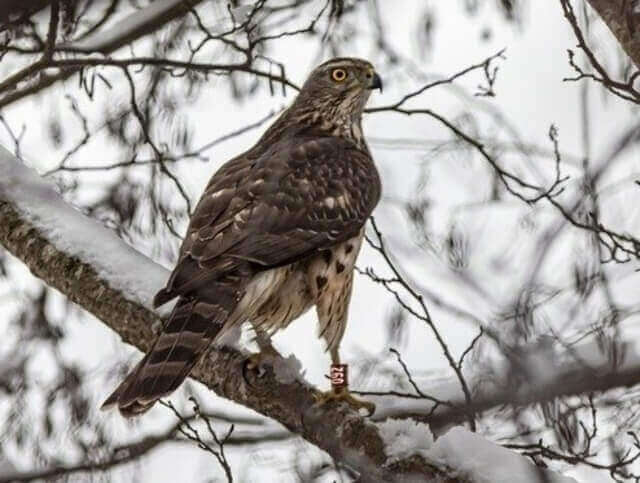
Frequently Asked Questions
How long can hawks survive without eating carrion?
Hawks have various survival strategies and adaptations, including the ability to go without food for several days. Empirical evidence suggests that some species can survive up to 10 days without eating. These adaptations allow hawks to remain agile and efficient during periods of scarcity.
Do all species of hawks eat carrion?
Hawk diet is diverse and includes small mammals, birds, reptiles, and insects. Scavenging behavior is observed in some species, but not all consume carrion. Research suggests that scavenging may be a survival strategy for hawks in times of food scarcity.
Is there a difference in the carrion preference between male and female hawks?
Research has not shown any significant difference in carrion preference between male and female hawks. Behavioral reasons for carrion consumption include nutritional needs and opportunistic feeding habits. Empirical evidence suggests that carrion consumption is a common behavior among many bird species.
Can hawks get sick from consuming carrion?
What bacterial risks and health consequences hawks face from consuming carrion is a pressing concern. Research indicates that while hawks have evolved mechanisms to resist pathogenic infections, contaminated carrion can still pose a threat to their health.
Are there any negative impacts on the environment if hawks consume too much carrion?
The role of hawks in the ecosystem as scavengers has implications on the scavenger population. Overconsumption of carrion by hawks can limit the availability of food for other scavengers, potentially causing negative impacts on the environment.
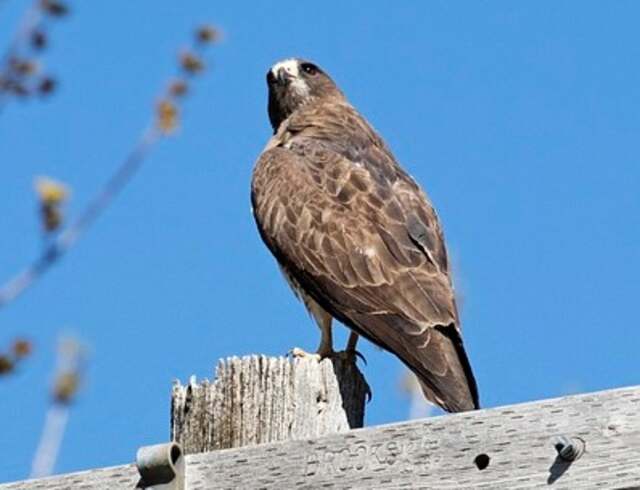
Conclusion
Hawks are known for their sharp talons, keen eyesight, and predatory behavior. However, these birds of prey also have a role in consuming carrion, or dead animals, which may have been overlooked by many.
Carrion can be an important source of nutrition for hawks, especially during times when hunting prey becomes difficult.
Research has shown that hawks not only consume carrion, but also play a vital role in the ecological balance by controlling the spread of diseases and scavenging on carcasses that would otherwise attract other scavengers.
Contrary to popular belief, hawks do not solely depend on hunting live prey to survive.
One interesting statistic is that approximately 20% of the diet of Red-tailed Hawks, one of the most common species of hawks in North America, consists of carrion.
This shows that carrion plays a significant role in the diet of these birds of prey. It also highlights the importance of carrion as a food source for hawks, especially during times of food scarcity.
Overall, understanding the role of carrion in hawks’ diet is important for conservation efforts and managing ecosystems.
While hawks are primarily known for their hunting prowess, their consumption of carrion should not be overlooked as it plays an important role in their survival and the overall health of the environment.

